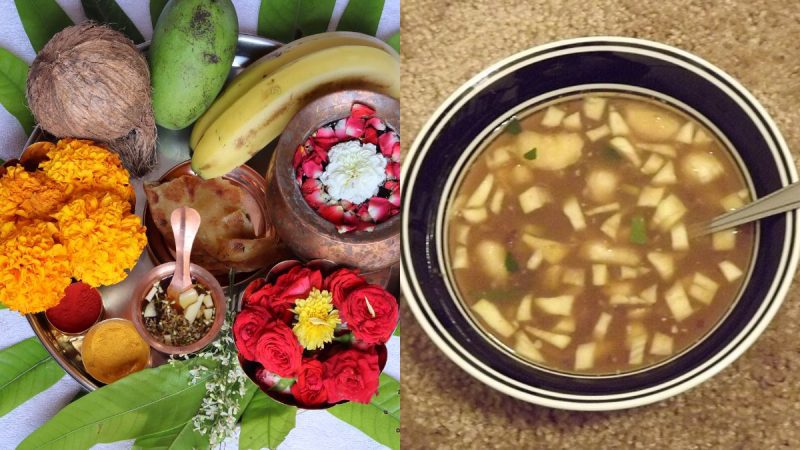Ugadi marks the beginning of a new year according to the Hindu lunar calendar, particularly celebrated with great enthusiasm in the southern states of India, notably Andhra Pradesh, Telangana, Karnataka, and parts of Tamil Nadu. The preparations for Ugadi commence well in advance. And Ugadi Pachadi is a festive recipe that incorporates every flavour imaginable, including bitter, astringent, salty, sweet, and sour.
What Is Ugadi Pachadi?
It is a symbolic reminder in Telugu and Kannada traditions to expect all kinds of experiences in the upcoming year. On this festival, Ugadi Pachadi is traditionally the first meal offered to the gods and then devoured as prasad by worshippers. Though neem blossoms, raw mango, jaggery, pepper powder, coconut, and salt are the main ingredients, other people also have versions of the same. Sliced banana, cashews, raisins, and fried grams (putnalu pappu) are some additional ingredients.
Ingredients also come with special meanings. The spicy or astringent taste of fresh mangoes represents the surprises in life. The sweet taste of jaggery represents happiness. Sadness is symbolised by neem flowers, which have a bitter flavour. The flavour of tamarind is sour, signifying unhappiness. The saltiness signifies apprehension about the phase that lies ahead. The taste of pepper, which represents rage, is hot or spicy.
Preparation of Ugadi Pachadi involves finely chopping or grinding these ingredients and blending them into a harmonious amalgamation of flavours. The meticulous balance of sweet, sour, bitter, tangy, spicy, and salty tastes mirrors the multifaceted nature of life.
Also read: From Obbattu To Ugadi Pachadi, 8 Best Ugadi Menus In Bengaluru For An Unforgettable Celebration
How To Make?
Ugadi Pachadi transcends its culinary essence. Here’s how you can make it:
Ingredients:
- Raw mango
- Neem flowers
- Jaggery
- Tamarind pulp
- Red chilli powder
- Salt
- Water
Steps:
- Soak one teaspoon of tamarind in half a cup of water for forty to sixty minutes. Next, press the pulp of the tamarind and set it aside. Put this tamarind pulp in a basin.
- Next, pour in ⅓ cup of water.
- Stir in ¼ cup chopped jaggery; stir well with a spoon to dissolve the jaggery. Add the raw mangoes, and cut finely, after that. Bananas, coconut, dry fruits, and roasted chana dal can also be added.
- Add the blooms of neem. If neem flowers are unavailable, you may use soaked methi seeds or powder.
- Add ¼ tsp of black pepper powder and mix. As needed, add a tsp of salt for seasoning. Blend thoroughly. Serve Ugadi Pachadi to your family after offering it to the gods.
Enjoy your homemade Ugadi Pachadi, savouring its unique blend of flavours and symbolic significance!
Cover image credits: Wikimedia Commons

